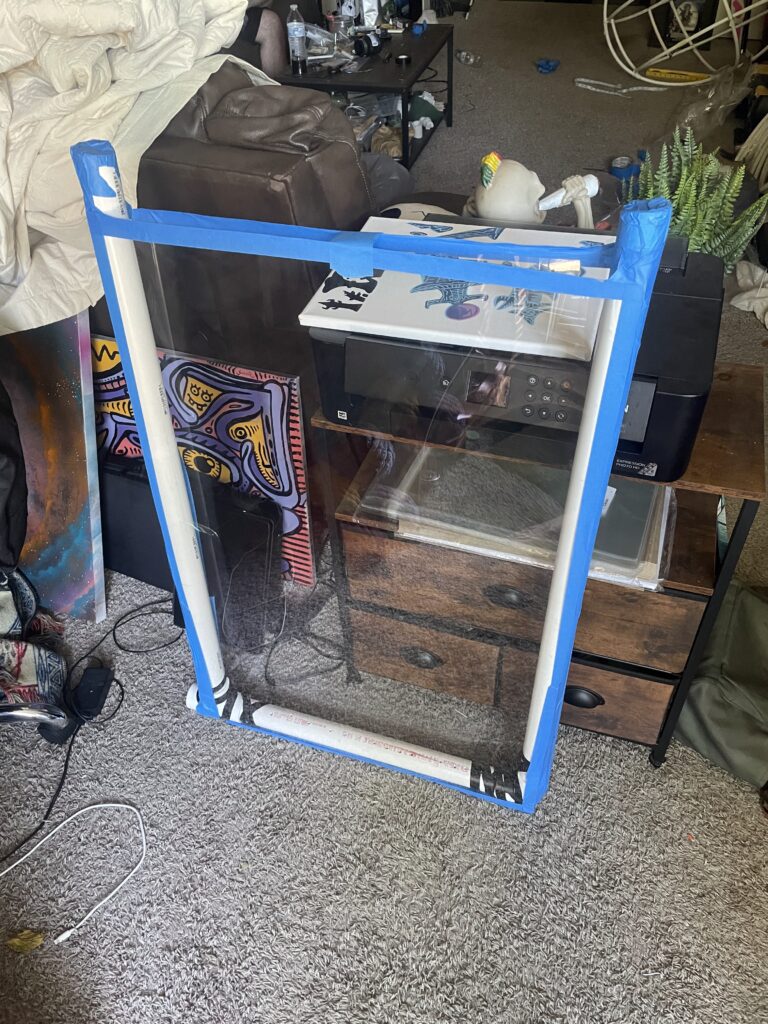This is the game mat design I chose for Reactor 21. The mat was created with the AI generated image as the backdrop, and the grid/text/mat sections were set up by me in Photoshop CC.


design courses, syllabi, schedules, resources and policies
This is part 4 of 5 in my sheep loops.
For my Smoke Screen prototype, I rigged up a PVC skeleton, which I then wrapped tape to connecting the acrylic plastic sheets to the PVC perimeter. I drilled holes into the bottom PVC pipe to act as a vent that slowly dispersed the fog upward through the acrylic pathway; and the end results are great. One thing I know is that this set up will look great with a rotoscoped video playing, as it would give the floating holographic screen illusion. Another thing I need to take into consideration for a final rendition, is the make and aesthetic of the smoke screens themselves, as although this rendition worked great as a prototype, it still looks a bit ghetto. Overall I think I’m making immense progress with everything and I am happy with how these results turned out.

So I was able to somewhat accomplish the trick I was going for, except the end result is no where near the level of intensity that I was going for. I used an old rotoscoped video of myself to project just an image of myself onto the smoke, however the clearness of the end result is just sorta good, not mind blowing or anything like that. I hope in the future I’ll be able to make this effect look realistic enough to yield quality holograms, or quite possibly, I may have to go for an entirely different route to achieve the holographic look; all while still incorporating a fog machine for aesthetic choices obviously. But if I do still use the fog machine idea, I may have to develop an exterior contraption of some sort as well, such as a clear thin guide that leads the smoke in a flat linear path. My only issue with this is its no longer holographic and is instead just projection onto a clear foggy surface. However I think testing this idea is still good to use as a backup.
Madison Hurst
Was it fun?- Camel Up was a really fun game, and I loved the whole concept of it. I thought it was different from a lot of games because you didn’t choose a camel to win. I liked how they used the concept of betting on the camels, like you were watching the Kentucky Derby. It was pretty fun trying to predict which camel would win the leg and trying to see who would win the most money.
What were the player interactions? – The player interactions is not directly affecting each other. I would say the theme of the game is “ best bet wins” in a sense. Every player gets the chance to roll the dice and see what camel moves if that is the action they take during their turn. I would say the only interaction that would affect the other players is how quickly someone picks up a bet card for camel, which would lessen the amount of coins the following person would get if they bet on that same camel.
How long did it take to learn?- We ended up watching a quick 8-minute video about how to play Camel Up, and briefly read over the directions. I would say it took about 15 minutes and around the end of the first leg to fully understand the game.
What was the most frustrating moment or aspect of what you just played? – The most frustrating part about the game was only having one action on your turn. For instance, I couldn’t place a bet and roll the dice to see which camel moved up on the space. Though I can see why there was only one action, because they came could’ve been a lot faster or too easy.
What was your favorite moment or aspect of what you just played? – My favorite moment of the game was the aftermath of placing a bet and winning. I really enjoyed reading the game and seeing which camel was more likely to win or get second place. I also didn’t mind the twist of the crazy camels going the other way in order to make the game more unpredictable.
Was there anything you wanted to do that you couldn’t? – One thing I wanted to do but couldn’t was place multiple bets in one action. I wanted to place two bets at once to possibly benefit me, but I couldn’t and had to wait a whole round. When it came back to my turn, either the reward of that bet decreased in value or the leg ended.
If you had a magic wand to wave, and you could change, add, or remove anything
From the experience, what would it be? – I would love to change the value of the betting cards and increase them. I think it would add more risk and reward to this game. I think I was rash with betting at some points because the risk/reward wasn’t high enough. The other thing I would change is something with the rogue camels, and making them more of an issue.
Is this a game you would play again? Yes , I would play this game again because it was super fun and I enjoyed the concept of it. I am not into any type of betting games, but I like this game because it’s not actually an issue, and it’s fun. I really loved reading the game and trying to see what cards to bet. I also loved the design of the board game and the camels.
Analyze the game using the 3 act structure.
In the first act of the game, every player is figuring out how to play and what cards, tokens, and dice mean. Everyone is not reading the game as quickly or to their full extent because we were still learning. I think the only part that everyone struggled to grasp was the player they chose and what bet they placed.
In the second act, everyone now understands the game, and we are in the second leg of the race. Bets are being placed, and we are starting to see which camel is taking the lead. In this case, this was the blue camel by far (ended up winning the race). Players are taking cards to see who is going to win the leg, and we are rolling the dice to see which camel is going to move. This is the act that the majority of the game is in, and things start to heat up as we close out the game.
The third act is when final bets are made and players are placing their player cards on the final winners/losers. I was rolling the dice and reading the other camel’s spots, and seeing which cards to bet in order to get the most amount of coins. The ending of the game is when the first camel crosses the line, and this is when all bets are final. Each player will count up how many coins they won/lost. The person with the most coins wins!
What are the collaborative and or competitive aspects of the game?- This game is a competitive game and not much of a collaborative one. The competitive side of the game was fighting for the highest betting cards and trying to get as many coins as possible in order to win. The collaborative side of the game was that every player had the chance to benefit from the same camel. There wasn’t a camel that any player couldn’t bet on.
What is the game’s metaphor, and which of the game’s mechanics stand out?- The theme of the game is a desert camel race, where the player is a spectator and betting on which camel will win. The mechanics of this game are the ability to stack camels and how they affect which camel is in 1st or 2nd place. There are rogue camels that affect where the camels are placed on the board. Moreover, the pyramid dice rolling plays a factor as a mechanical part of the game because there is uncertainty and randomness in it, which can either push the camels to the lead or not even move a space.
For my next video, I’m going to stick with the 8 bit arcade style. I just think it’s really cool and it’s a good way to loop back to the original loop.
Currently finishing up the last animation. I had trouble thinking of a good way to involve conflict but I figured it out. What I’m gonna do is push the third video back and put in another video before the players come on the ice. It’s gonna be the player and the coach having a deep conversation in the locker room before overtime starts.